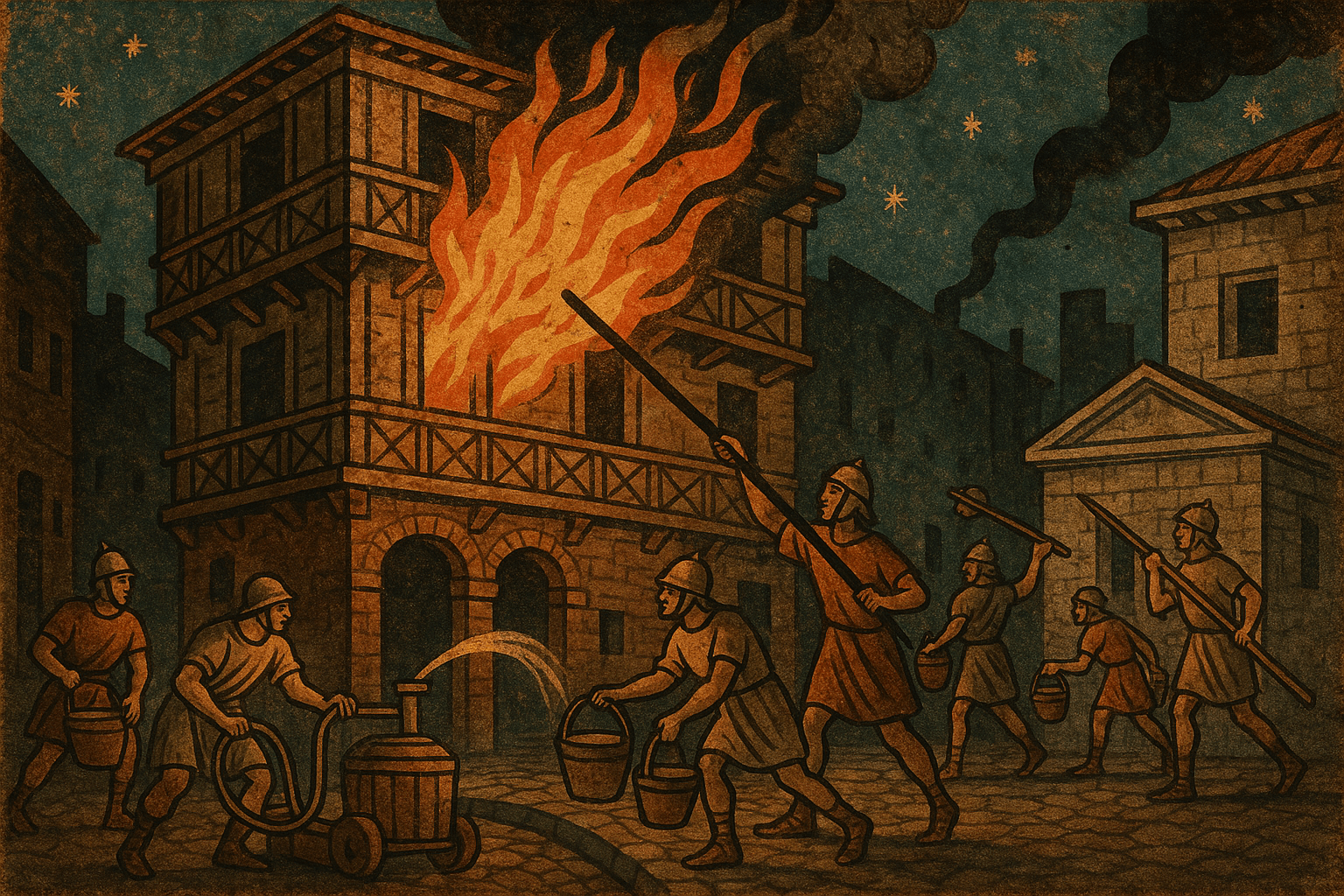Before the Vigiles: A City Built to Burn
To understand the necessity of the Vigiles, one must first picture the Roman urban landscape. Most of the populace lived in multi-story apartment buildings called insulae. These were notoriously shoddy constructions, built cheaply with timber frames, packed together along narrow, winding streets. Fire codes were non-existent. Open flames were used for everything from cooking to heating and lighting. A fire starting on the ground floor of an insula could engulf the entire structure in minutes, spreading with terrifying speed to its neighbors.
Prior to Augustus, firefighting was a chaotic and often corrupt affair. Private fire brigades existed, but their motives were questionable. The most infamous was run by the fabulously wealthy Marcus Licinius Crassus. His brigade would rush to a fire, but before taking any action, Crassus would offer to buy the burning building—and sometimes the neighboring properties—at a drastically reduced price. If the desperate owner refused, Crassus’s men would simply stand by and watch it burn. It was disaster capitalism at its most brutal, highlighting the desperate need for a public service dedicated to saving lives and property, not profiting from them.
Order from the Ashes: Augustus Creates the Vigiles
The turning point came in 6 AD, when a particularly devastating fire swept through the city, consuming vast swathes of its districts. Augustus, realizing that ad-hoc measures were no longer sufficient for his sprawling capital, established a new paramilitary corps: the Vigiles Urbani, or “Watchmen of the City.”
This was a revolutionary concept. The Vigiles were organized with military precision into seven cohorts, each composed of roughly 500 to 1,000 men. Each cohort, commanded by a tribune, was responsible for two of Rome’s fourteen administrative regions. The entire corps was under the command of a single prefect, the Praefectus Vigilum, a man of high equestrian rank who answered directly to the emperor. This centralized command structure ensured a coordinated and rapid response to emergencies anywhere in the city. Their barracks, known as stationes, were strategically placed throughout their assigned regions, with smaller watchtowers, or excubitoria, acting as lookouts.
The Men of the Watch: A Path to Citizenship
One of Augustus’s most brilliant moves was in how he staffed this new force. The Vigiles were recruited almost exclusively from the ranks of liberti, or freedmen. This served a dual purpose. It provided a vast pool of manpower without drawing from the legions needed for imperial defense. More importantly, it offered freedmen a unique and respectable path to full Roman citizenship. After completing a term of service (initially six years), a Vigilis and his children would be granted this coveted legal status. It was a powerful incentive that ensured a steady stream of dedicated recruits, transforming a marginalized class into guardians of the city.
Battling the Blaze: Tools and Tactics
Fighting a fire in ancient Rome was a brutal and dangerous business. The Vigiles were equipped with the best technology of the day, though it seems primitive by modern standards. Their arsenal included:
- Siphones: These were rudimentary double-piston pumps, more like large syringes, that could project a jet of water. They required a team of men to operate and had limited range, but they were the most advanced piece of firefighting tech at the time.
- Hamae (Buckets): The bucket brigade was the backbone of any firefighting effort. Vigiles would form long chains to pass buckets of water, often filled from the city’s famous aqueducts and fountains, to the scene of the fire.
- Dolabrae (Pick-axes) and Secures (Axes): Often, the most effective way to stop a fire from spreading was not to extinguish it but to contain it. The Vigiles were experts in demolition, using heavy axes to tear down buildings and create firebreaks, robbing the blaze of its fuel.
- Centones: These were heavy woolen blankets soaked in water or, more effectively, vinegar. They were used to beat out smaller flames or to shield the firefighters from heat.
- Scala (Ladders): Essential for reaching the upper floors of the burning insulae.
The Vigiles were split into specialists. The aquarii managed the water supply, the siphonarii operated the pumps, and the uncinarii wielded grappling hooks to pull down burning timbers. Their first priority was always rescue, but their primary tactic was containment. When the Great Fire of 64 AD ravaged Rome during Nero’s reign, the Vigiles were on the front lines, fighting a losing battle against a firestorm so immense that it would reshape the city forever.
Guardians of the Night
The Vigiles’ duties didn’t end at sunrise. As their name implies, they were also the city’s night watch. Patrolling the dark, unlit streets of Rome, they were a deterrent against crime. They were empowered to apprehend burglars, chase down runaway slaves, and break up street brawls. While they were not a detective force like the fictional detectives of historical novels, they were the closest thing Rome had to a professional police force.
Carrying lanterns and their firefighting tools—which could double as formidable weapons—they maintained public order and kept an eye out for fire hazards. Any citizen caught with an unsafe fire could expect a stern warning or even a flogging from the patrollers. They were a constant, visible presence that made the chaotic city a far safer place to sleep at night.
For over 500 years, the Vigiles Urbani served Rome. They were a brilliant Augustan innovation born of necessity—a pragmatic solution to the twin threats of fire and crime that plagued all ancient cities. They professionalized emergency response, saved countless lives, and provided a model of public service that is the direct ancestor of the fire departments and police forces we rely on today. They were the unsung heroes who stood guard while the Eternal City slept, ever watchful for the flicker of a flame in the dark.
